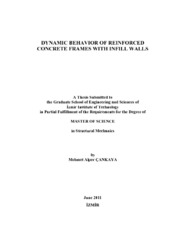Please use this identifier to cite or link to this item:
https://hdl.handle.net/11147/3134Full metadata record
| DC Field | Value | Language |
|---|---|---|
| dc.contributor.advisor | Dönmez, Cemalettin | - |
| dc.contributor.author | Çankaya, Mehmet Alper | - |
| dc.date.accessioned | 2014-07-22T13:50:56Z | - |
| dc.date.available | 2014-07-22T13:50:56Z | - |
| dc.date.issued | 2011 | - |
| dc.identifier.uri | http://hdl.handle.net/11147/3134 | - |
| dc.description | Thesis (Master)--Izmir Institute of Technology, Civil Engineering, Izmir, 2011 | en_US |
| dc.description | Includes bibliographical references | en_US |
| dc.description | Text in English; Abstract: Turkish and English | en_US |
| dc.description | xiv, 132 leaves | en_US |
| dc.description.abstract | Current practices utilize infill walls as insulation or partition material but not as a structural material. The main reason for this choice is the complexity of the partition wall-frame interaction behavior. Therefore infill walls typically ignored in the structural designs. However, existence of partition walls heavily effect stiffness, strength and behavior of structures. The main purpose of the presented study is the investigation of the dynamic parameters of reinforced concrete frames with and without infill walls. Moreover, lateral strength, stiffness and energy dissipation properties of the frames are also studied. In order to achieve the purpose four planar, one-bay, four story RC frames with 1/5 scale are designed, constructed and tested. In the frames main parameters are selected as presence of partition walls and ductile/non-ductile reinforcement detailing. Experiments are consisted of static and dynamic tests. In static tests each frame subjected to lateral loads that were applied at the each story level to provide a lateral loading increasing with height. Lateral load levels were controlled by the drift levels in the first story. Dynamic tests were performed at the end of each deformation level and modal analysis methods are utilized. Analyses have shown that existence of partition walls in the frame increased the natural frequencies of the frames. However, reinforcement detailing did not have a significant effect on natural frequencies. It is also observed that the natural frequencies of the frames decreased with increasing damage level. On the other hand, presence of partition walls effected the damaged behavior of the frames and drift is observed to concentrate to the first story with the increasing level of damage. And finally stiffness, strength and energy dissipation properties of frames with partition walls are observed to be dramatically higher than the frames without partition walls. | en_US |
| dc.language.iso | en | en_US |
| dc.publisher | Izmir Institute of Technology | en_US |
| dc.rights | info:eu-repo/semantics/openAccess | en_US |
| dc.subject.lcsh | Structural dynamics | en |
| dc.subject.lcsh | Reinforced concrete | en |
| dc.subject.lcsh | Concrete panels | en |
| dc.subject.lcsh | Concrete masonry | en |
| dc.subject.lcsh | Materials--Dynamic testing | en |
| dc.title | Dynamic Behavior of Reinfor Ced Concrete Frames With Infill Walls | en_US |
| dc.type | Master Thesis | en_US |
| dc.institutionauthor | Çankaya, Mehmet Alper | - |
| dc.department | Thesis (Master)--İzmir Institute of Technology, Civil Engineering | en_US |
| dc.relation.publicationcategory | Tez | en_US |
| dc.identifier.wosquality | N/A | - |
| dc.identifier.scopusquality | N/A | - |
| item.languageiso639-1 | en | - |
| item.cerifentitytype | Publications | - |
| item.openairetype | Master Thesis | - |
| item.openairecristype | http://purl.org/coar/resource_type/c_18cf | - |
| item.fulltext | With Fulltext | - |
| item.grantfulltext | open | - |
| Appears in Collections: | Master Degree / Yüksek Lisans Tezleri | |
Files in This Item:
| File | Description | Size | Format | |
|---|---|---|---|---|
| T000941.pdf | MasterThesis | 9.97 MB | Adobe PDF |  View/Open |
CORE Recommender
Page view(s)
372
checked on Jun 16, 2025
Download(s)
108
checked on Jun 16, 2025
Google ScholarTM
Check
Items in GCRIS Repository are protected by copyright, with all rights reserved, unless otherwise indicated.